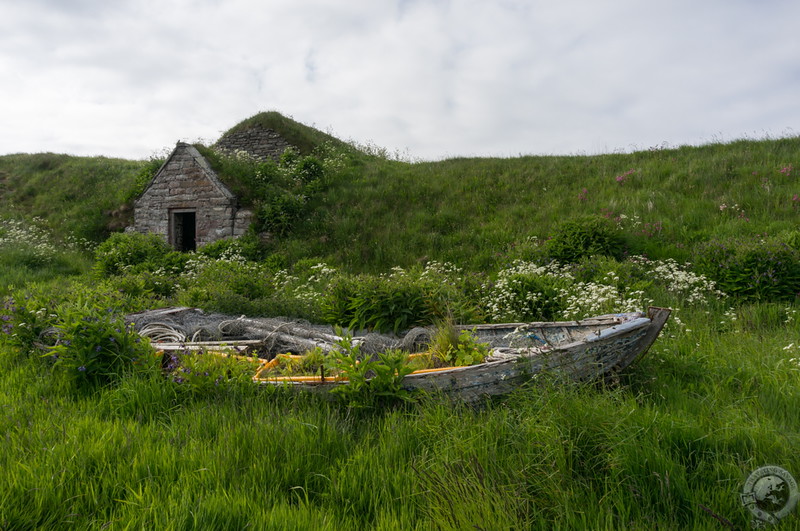In Scotland’s far north, a land of rearing mountains and sweeping glens, you will find a corner that is broad, flat, and sliding down to the sea. This northeastern section, a region called Caithness, stands apart from its neighbors, and what it lacks in mind-blowing scenery it makes up with the highest concentration of people in the far northern highlands. The towns of Wick and Thurso, both near 8,000 people, stand on Caithness’s eastern and northern coasts, respectively, and dwarf Ullapool, the largest town on the northwestern coast. It’s easy to see why. The broad, float expanse of Caithness is ideal for raising livestock, and indeed sheep and especially cattle were everywhere.
Caithness stands on a 4,000 meters of red sandstone, and this geology aligns the area more closely with Orkney and Shetland than Wester Ross, Easter Ross, and Sutherland. Historically, the kings of Norway disputed Scotland’s claim on Caithness when they held the Orkney Islands, which are clearly visible on a clear day from Caithness’s shores. But the Norse weren’t the first people here. When they arrived, the land of Caithness was probably Pictish, descendants of the Kingdom of Cat, named after one of the seven sons of the Picts’ near-mythology ancestor Cruithne. Etymologically, Caithness is a Pictish/Norse hybrid word meaning “headland of the Cat people.” Pretty awesome, don’t you think?
Impressions
There are a surprising number of castles. I haven’t associated Caithness with castles in the past, but here you’ll find the Freswick Castle, Keiss Castle, Girnigoe Castle/Castle Sinclair, and many others. There are some truly outstanding ruins brooding over the coast with Shakespearean aplomb. But there’s more than just ruins here. Ackergill Tower is a 5-star luxury castle that you can book rooms in, and the Castle of Mey is the former holiday home of the Queen Mother and a fine pile looking out toward Orkney. If you’re a castle hunter then you ought to consider where Caithness fits into your vacation plans.
Unrefined history is everywhere. Beyond the castles which quite obviously stand apart from Caithness’s agricultural countryside, there’s a deep vein of ancient history underlying the region. Brochs, Iron Age dwellings of drystone construction, are more prevalent here than anywhere else in Scotland. I didn’t see any examples on a level with Mousa Broch in Shetland, the Broch of Gurness in Orkney, or even Dun Dornigail Broch in Sutherland, but they might be here. Many of these ancient sites remain beneath the ground, little more than rumpled hills, not yet excavated. While I was in Caithness I stayed right down on Keiss harbor. Sarah and I walked five minutes north in gale-force wind and found one of these unexamined brochs. It’s an exciting prospect that there are still secrets waiting to be told. Perhaps in one of these hidden sites lies the Pictish “Rosetta Stone,” the key to understanding their culture, language, and art. Money for digs is short, and there is an ethical question about such excavations as well. The local Caithness Broch Centre is a nice little museum with more information.
Lighthouses and seabirds are a draw. Caithness has a large coastline so you can be sure there will be lighthouses and seabirds everywhere. Of particular note, at Dunnet Head RSPB you will find the clifftops of Britain’s northernmost point littered with pretty flowers and swarming with guillemots, kittiwakes, razorbills, and puffins. Further east stand the Duncansby Head stacks and lighthouse, just beyond John O’Groats. These two sites present some of Caithness’s most beautiful cliffs and coasts with additional interest for bird-watchers and lighthouse aficionados.
Tourism is lagging behind the rest of Scotland. Caithness has the curious feel of being a bit behind the times in terms of tourism infrastructure. The irony is that lots of tourists come through Caithness to catch ferries to the Orkney Islands. There are castles, ancient sites, and even a couple of distilleries up here, but the presentation of these places, in general, could be improved. Perhaps with the recent creation of the North Coast 500 more tourism pounds will flow into this region and add a bit of polish. That said, it also means Caithness flies under the radar and provides a clearer view of daily life in Scotland.
I’ll be back next week with a wrap up of my trip to northern Scotland. In the meantime, check out Facebook, Twitter, and Instagramfor extra photos, updates, and thoughts from my recent trip around the North Coast 500!


Looks like a great spot to go off the beaten track in Scotland … will have to steer my rental car there when I get there next year!